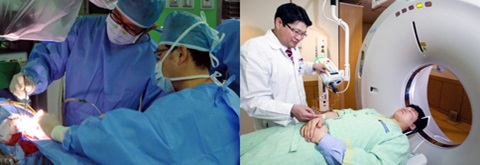
Diagnosis • Treatment of Stroke within 20 minutes of Hospital Admission
Swift action can save stroke patient’s life and determines the degrees of aftereffect, thus, prompt medical treatment followed by accurate diagnosis is the core of stroke patient care. Because of this, Incheon St. Mary’s Hospital of the Catholic University of Korea has established the first specialized stroke care unit and neurosurgical center in Incheon area, and operated special task force team for stroke care to strictly follow the guideline of treating stroke patients within 20 minutes of hospital arrival since 2005. Special task force team for stroke care consists of 50 staffs including 21 professors specialized in neurology, neurosurgery, rehabilitation, radiology, Korean medicine, and neuropsychiatry provides immediate and high quality medical treatment 24/7. Neurosurgical Center of Incheon St. Mary’s Hospital is also equipped with state-of-the-art stroke diagnosis and treatment device of 64-Channel 3D MDCT, 3T MRI, Angiography, Neuro-Microscope, Navigator, 16-Channel Operation Monitor, and Ultrasonic TCD. Neurological Center of Incheon St. Mary’s Hospital has received top rating on Acute Stroke Treatment Adequacy Assessment by Health Insurance Review and Assessment Service for 5 consecutive years since 2006.
Minimally Invasive Endoscopic Brain Surgery for Brain Tumor
Incheon St. Mary’s Hospital performs endoscopic surgery for cranial brain tumor such as meningioma, pituitary adenoma, and craniopharyngioma. “Endoscopic brain tumor surgery inserts the endoscope through the patient’s nostril to approach tumor area from the outside of the brain in order to remove the tumor without damaging brain tissue, or inserts the endoscope through the 2~3cm excision made on the crease of the eyebrow to remove the tumor. Only around 10 medical institutions in Korea are able to perform this type of advanced surgery,” said Director HAN Youngmin of Neurological Center. Other brain surgeries are also performed after precisely locating tumor using the latest medical devices such as Neuro-Microscope and Navigator. “Unlike conventional brain surgery, minimally invasive endoscopic surgery barely leaves scars, thus, patient satisfaction is very high,” said Director Han.
Neuropathic pain as well as trigeminal neuralgia is treated by radiosurgery using Novalis Tx. Torticollis that accompanies lateral flexion contracture causing one’s head tilted to one side is treated by deep brain stimulation along with medication and botox injection. Deep brain stimulation is a surgical treatment involving implantation of a type of pacemaker device to generate impulse for electrical stimulation on the part of the brain associated with torticollis. “Deep brain stimulation is very effective as it minimizes nerve damage and can be replaced with new treatment at any time,” said Professor HEO Ryeung.